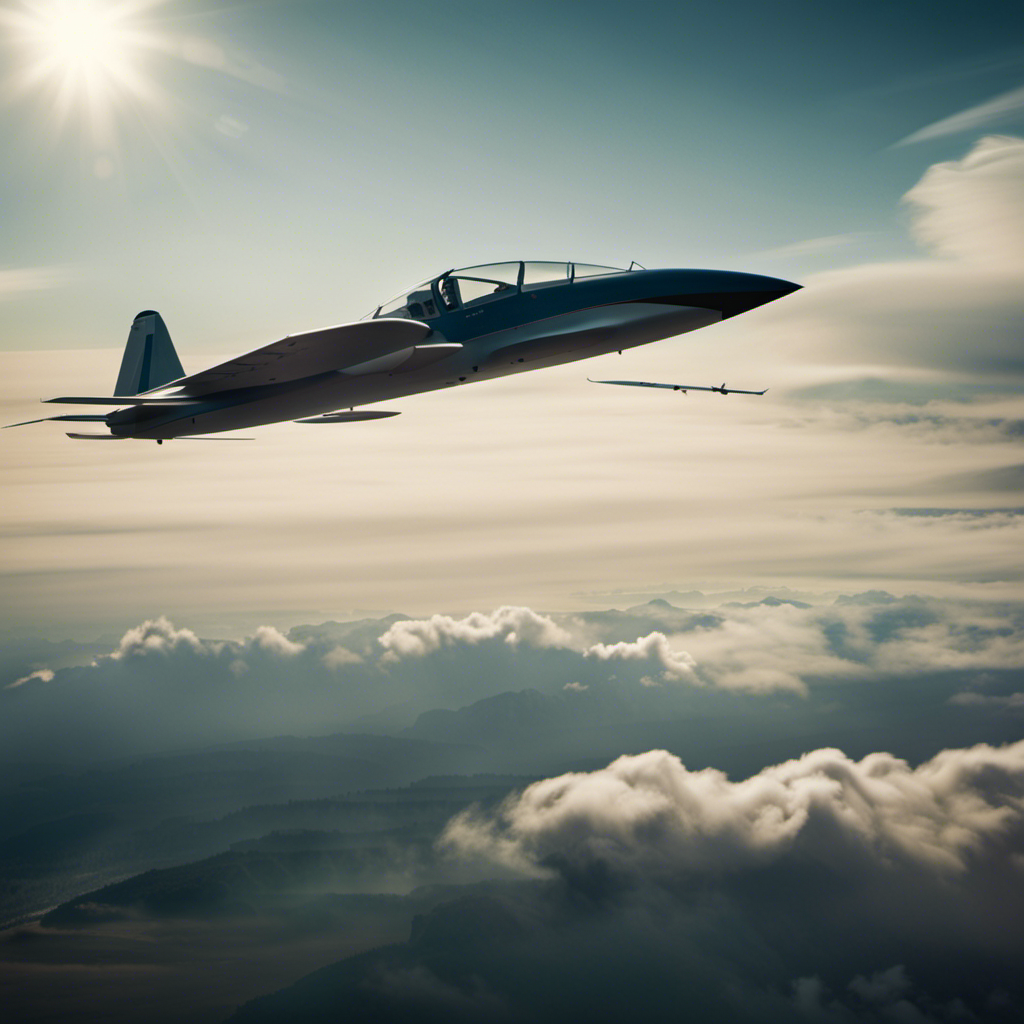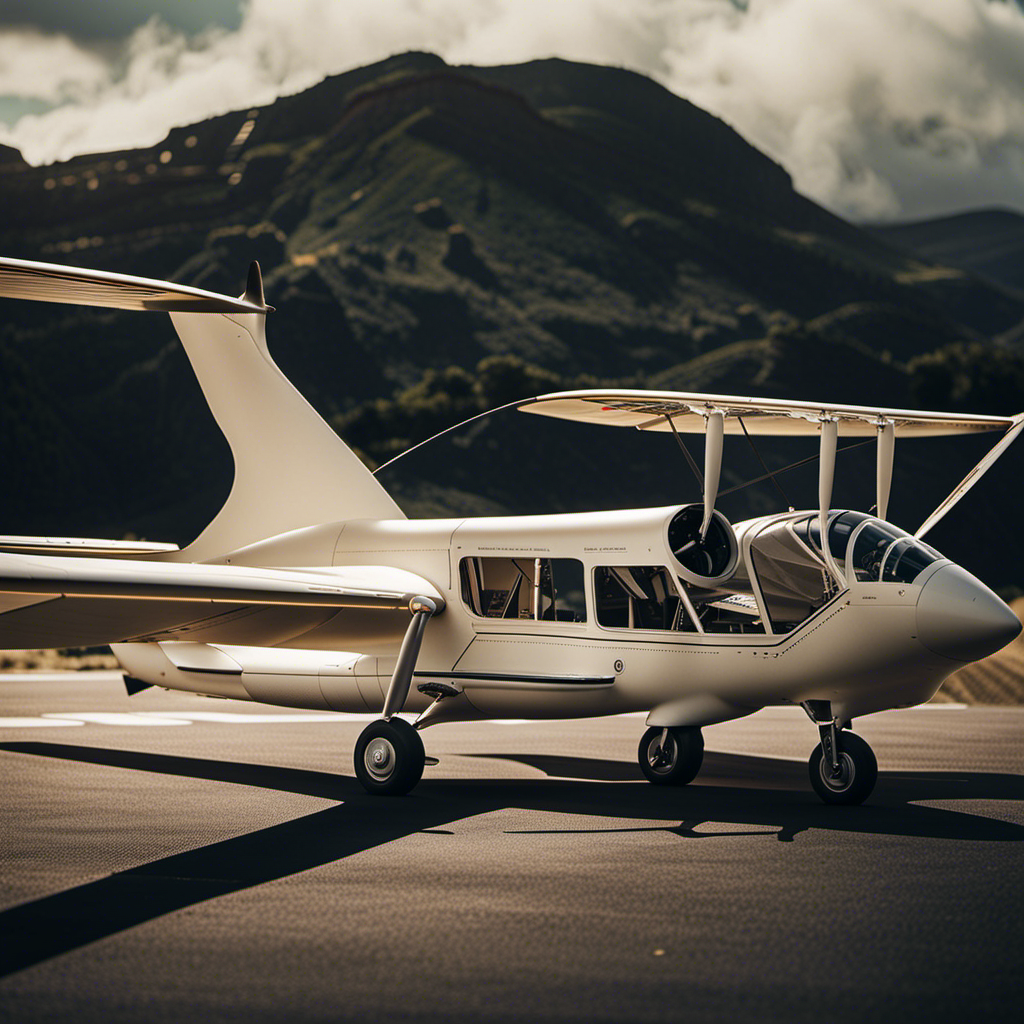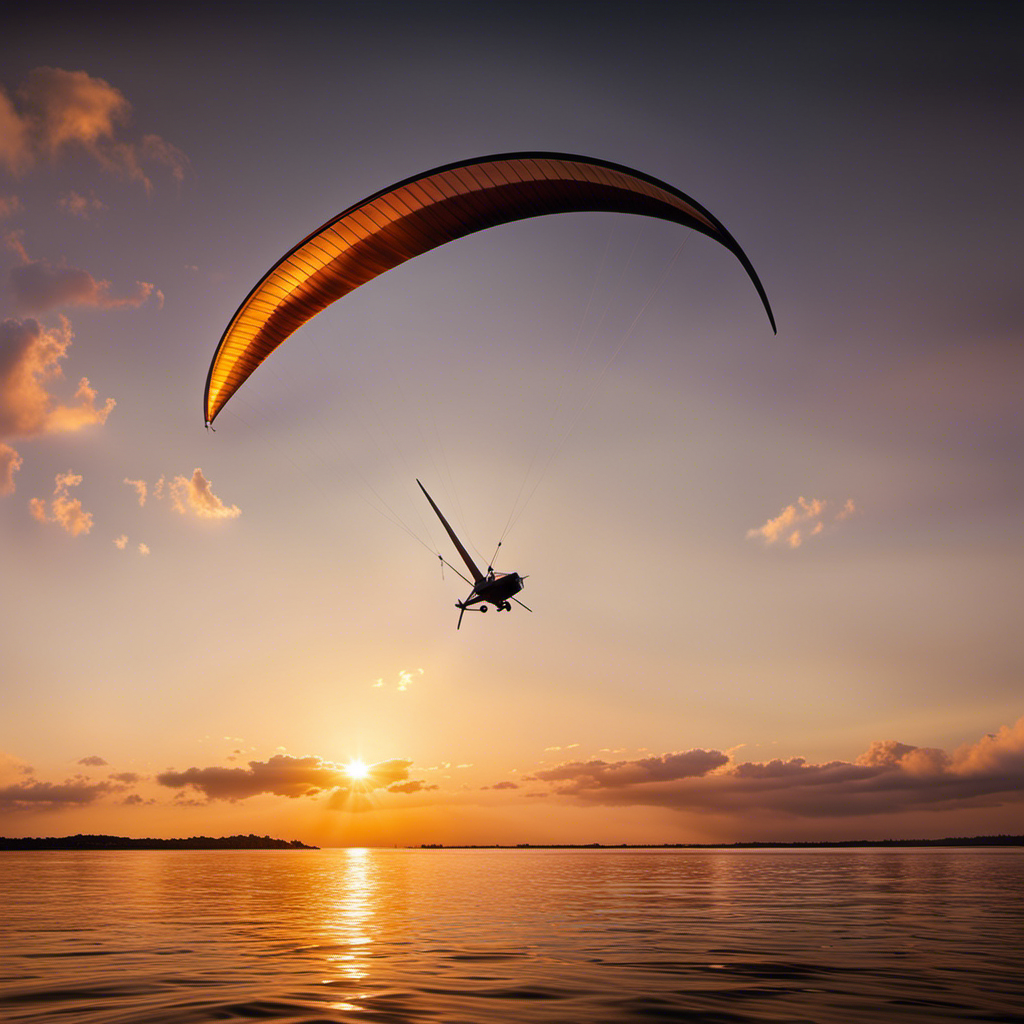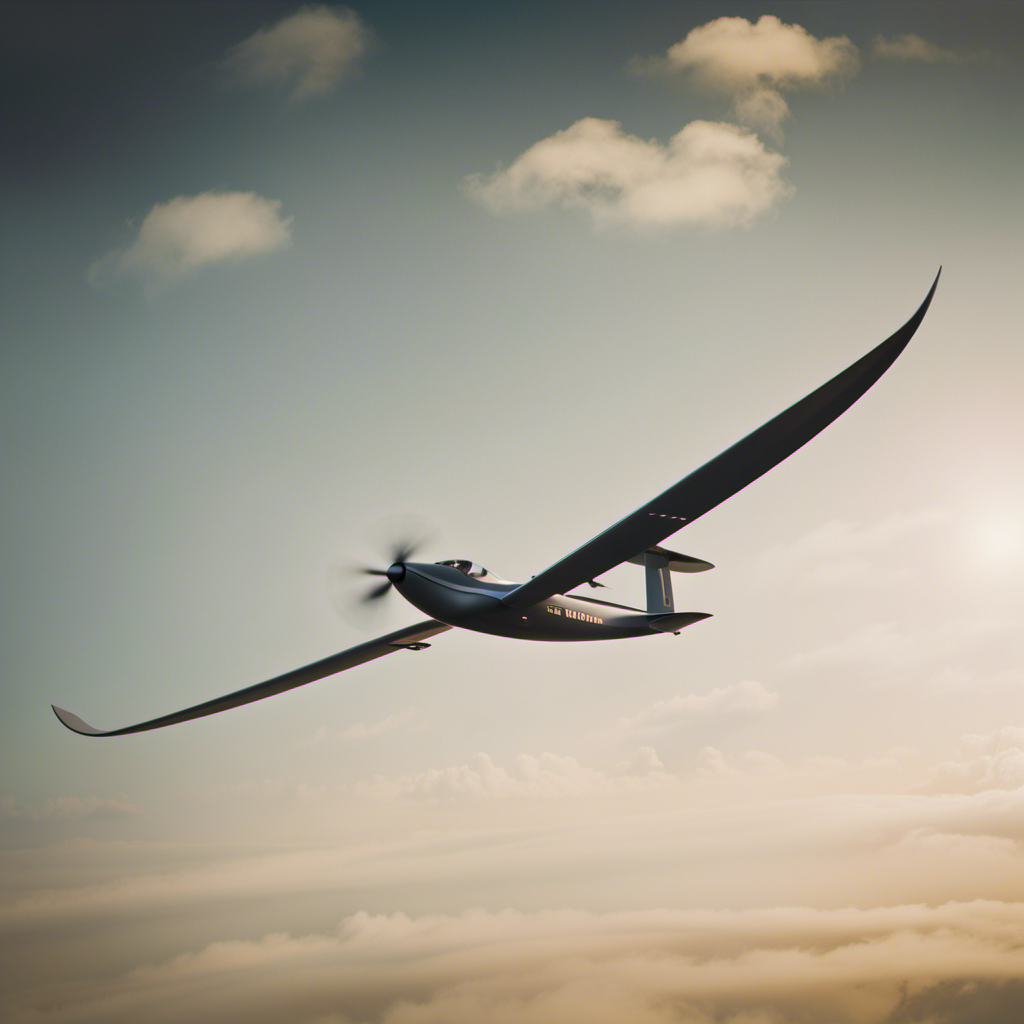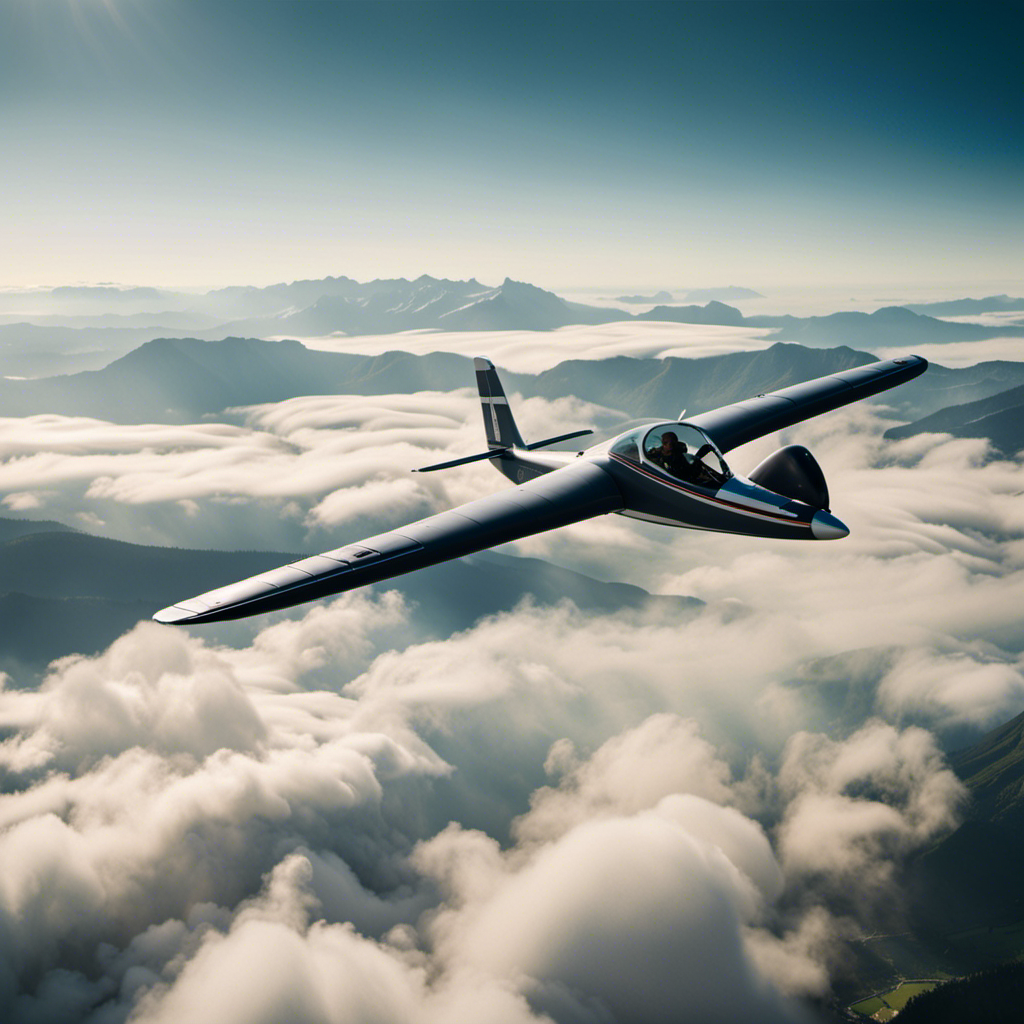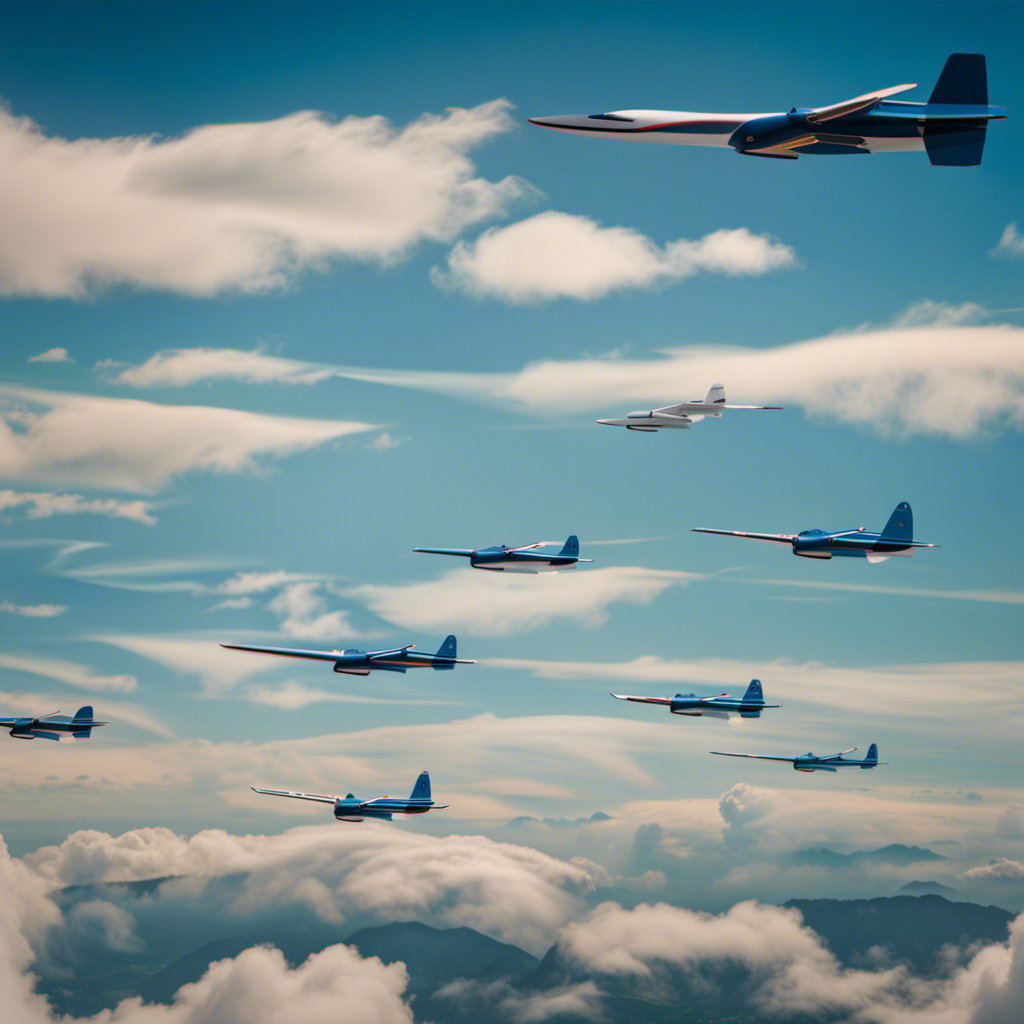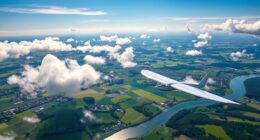While soaring through the sky, the noticeable distinction between gliders and airplanes becomes strikingly clear.
Gliders, elegant and graceful, rely solely on the forces of nature to stay aloft, while aircraft, powered by engines, conquer the air with brute force.
Understanding the differences between these two aerial marvels is crucial for aviation enthusiasts and professionals alike.
In this article, I will delve into the intricacies of propulsion systems, flight capabilities, and the purpose behind these remarkable machines.
So buckle up and prepare for an enlightening journey into the world of gliders and aircraft.
Key Takeaways
- Gliders rely on gravity and thermals for propulsion, while aircraft use engines for continuous and controlled power.
- Gliders have advantages such as fuel efficiency and silent flight, but they have limitations in speed and range compared to powered aircraft.
- Gliders are highly maneuverable and offer a unique opportunity for silent flight, making them cost-effective and providing a more accessible entry into aviation.
- Gliders have a smaller environmental impact, produce minimal noise pollution, and have a lower accident risk due to slower speeds and reliance on air currents.
Propulsion Systems
Aircraft typically use engines, while gliders rely on gravity and thermals for propulsion. The difference in propulsion systems affects the overall performance and efficiency of these two types of aircraft.
In terms of propulsion efficiency, aircraft equipped with engines have the advantage. Engines provide a continuous and controlled source of power, allowing aircraft to generate thrust and maintain a steady speed. The aerodynamic design of aircraft is optimized to enhance propulsion efficiency, with streamlined shapes and powerful engines.
On the other hand, gliders rely on gravity and thermals to stay aloft. Gravity provides the initial energy for the glider to descend, while thermals are rising columns of warm air that gliders can use to gain altitude. Gliders have a more efficient glide ratio, which measures the forward distance traveled compared to the altitude loss. They are designed to minimize drag and maximize lift, allowing them to stay aloft for extended periods.
In contrast to aircraft, gliders do not require fuel or engines, making them environmentally friendly and cost-effective.
Ability to Stay Aloft
To stay aloft, gliders rely solely on the power of the wind. Unlike powered aircraft, which use engines to generate thrust and maintain altitude, gliders utilize the natural air currents to sustain flight. This gives gliders both advantages and disadvantages compared to traditional aircraft.
Advantages of gliders:
- Fuel efficiency: Gliders do not require fuel, making them extremely cost-effective to operate.
- Silent flight: Without an engine, gliders produce minimal noise, allowing for a peaceful and serene flying experience.
- Greater maneuverability: Gliders are designed to be highly maneuverable, allowing pilots to perform intricate aerial maneuvers with ease.
Disadvantages of gliders:
- Limited range: Gliders are dependent on thermals and air currents to stay airborne, which limits their range and ability to travel long distances.
- Weather dependency: Gliders heavily rely on favorable weather conditions, such as thermals and updrafts, which can be unpredictable and may restrict flight opportunities.
- Inability to take off on their own: Gliders require a tow plane or a winch to launch, which adds complexity to the flight operation.
Transitioning into the next section about purpose, it is important to understand the unique capabilities and limitations of gliders when considering their various applications.
Purpose
When considering the purpose of flying in a glider, you’ll discover a unique opportunity to experience the freedom and serenity of silent flight. Gliders, also known as sailplanes, are aircraft designed to fly without an engine. They rely on the forces of nature, such as thermals and updrafts, to stay aloft. The purpose of flying in a glider can vary from recreational to competitive. Glider pilots often seek the thrill of soaring through the skies, feeling the wind beneath their wings and the sense of pure tranquility that comes with it.
One of the main advantages of gliders is their cost-effectiveness. Compared to traditional powered aircraft, gliders have lower operating costs, as they do not require fuel or regular engine maintenance. This makes gliding an attractive option for those looking to experience the joy of flying without breaking the bank. Additionally, the simplicity of gliders allows for a more accessible and affordable entry into aviation.
Takeoff and landing in a glider involves specific procedures and techniques, which will be discussed in the subsequent section. These steps are crucial in ensuring a safe and successful flight.
Takeoff and Landing
One of the key aspects of flying a glider is mastering the techniques for takeoff and landing. In order to efficiently take off, glider pilots utilize various techniques to generate enough lift to become airborne. These techniques include launching with the assistance of a tow plane or winch, or by utilizing a slope or ridge for a technique known as slope soaring.
During takeoff, it is crucial to maintain a proper angle of attack to ensure a smooth ascent.
When it comes to landing, gliders are equipped with landing gear that is specifically designed for their unique requirements. The landing gear of a glider is typically retractable, allowing for a streamlined and efficient flight. This retractability also helps reduce drag during takeoff and cruising, further enhancing the glider’s performance.
Once the glider approaches the landing area, the pilot must carefully manage the descent rate and speed to ensure a safe touchdown. This is achieved by adjusting the glide path and using the available lift to maintain control.
Transitioning to the control systems of a glider, it is important to note that they differ from those of powered aircraft. Gliders rely on a combination of weight shifting and control surfaces, such as ailerons, elevators, and rudders, to maneuver through the air. These control systems allow the pilot to maintain stability, make turns, and adjust the glider’s pitch and roll.
Control Systems
The control systems of a glider involve a combination of weight shifting and control surfaces like ailerons, elevators, and rudders. These control systems play a crucial role in maneuvering the glider and ensuring its safety.
When it comes to control systems, safety considerations are of utmost importance. Glider pilots must have a thorough understanding of how these systems work and how to use them effectively. Let’s take a closer look at the different control surfaces and their functions:
| Control Surface | Function |
|---|---|
| Ailerons | Control roll motion by changing the wing’s angle of attack |
| Elevators | Control pitch motion by changing the aircraft’s nose-up or nose-down attitude |
| Rudders | Control yaw motion by changing the aircraft’s left or right direction |
By manipulating these control surfaces, glider pilots can maintain balance and control over the aircraft. It is essential to have a good understanding of these systems and their limitations to ensure a safe flight.
Now, let’s transition into the next section about speed and range.
Speed and Range
Glider control systems play a crucial role in maintaining speed and range during flight. The ability to stay aloft and cover long distances is essential for gliders, as they rely on air currents and thermals for propulsion rather than traditional propulsion systems. Unlike aircraft, which have engines to generate thrust, gliders must carefully manage their speed and range to maximize their time in the air. Gliders have a lower risk of accidents due to their slower speeds and reliance on air currents, which allows for more safety considerations. This is in contrast to aircraft, which have higher safety standards and regulations due to their use for transportation purposes.
In terms of accessibility, gliding clubs and facilities are more widespread and accessible compared to airports and airfields required for aircraft operations. This accessibility is due to the fact that gliders are lighter and can take off and land in smaller areas, such as grass fields. Aircraft, on the other hand, require access to airports and airfields, which may be limited in some areas.
Transitioning into the next section about pilot requirements, gliders have different pilot requirements compared to aircraft.
Pilot Requirements
Pilots of gliders must meet different requirements than those of aircraft, including specific training and certification. As a glider pilot, I understand the importance of rigorous training and licensing to ensure safe and competent operation of these unique aircraft. Here are some key points to consider regarding pilot requirements for gliders:
-
Training: Glider pilots undergo specialized training that focuses on the unique aspects of glider flying, such as aerodynamics, thermals, and ridge soaring. This training typically includes both theoretical knowledge and practical flight training.
-
Certification: To operate a glider, pilots must obtain a glider pilot license, which is distinct from a regular aircraft pilot license. This license demonstrates the pilot’s proficiency in glider-specific skills and knowledge.
-
Solo Flight: Before soloing in a glider, pilots must complete a specified number of flight hours under the supervision of a flight instructor. This ensures that pilots gain sufficient experience and confidence before flying solo.
-
Continuing Education: Glider pilots are encouraged to pursue continuing education opportunities to enhance their skills and stay updated on the latest glider flying techniques and safety practices.
Understanding these pilot requirements is essential for aspiring glider pilots and those interested in the differences between gliders and traditional aircraft. With the appropriate training and certification, glider pilots can safely navigate the skies and enjoy the unique experience of soaring through the air.
As we explore the topic of gliders further, it is crucial to consider the safety considerations associated with these aircraft.
Safety Considerations
As a pilot, it’s important to understand the safety considerations when comparing gliders and aircraft.
Gliders, with their slower speeds and reliance on air currents, have a lower risk of accidents compared to aircraft.
However, it’s crucial to note that aircraft have higher safety standards and regulations due to their primary use for transportation.
Gliders have a lower risk of accidents due to their slower speeds and reliance on air currents
With their slower speeds and dependence on air currents, gliders pose a lower risk of accidents compared to powered aircraft. This is due to the unique nature of glider performance, which relies on the skill of the pilot to utilize rising air currents to stay aloft.
Gliders typically fly at much lower speeds than powered aircraft, reducing the risk of collisions and other accidents. Additionally, gliders are designed to be lightweight and have a simple construction, minimizing the likelihood of mechanical failures. However, it is important to note that gliders still require proper training and adherence to safety protocols to ensure a safe flight.
Transitioning into the subsequent section, while gliders have their own safety considerations, it is worth noting that powered aircraft have higher safety standards and regulations due to their use for transportation.
Aircraft have higher safety standards and regulations due to their use for transportation
Due to their role in transportation, aircraft have stricter safety standards and regulations. This is because they carry passengers and cargo, and any mishap can have serious consequences.
One of the key aspects of aircraft safety is the pilot requirements. Pilots must undergo extensive training and meet specific qualifications before they can operate an aircraft. This includes obtaining a pilot’s license, which requires a certain number of flight hours and passing written and practical exams. Additionally, pilots must undergo regular medical examinations to ensure they are physically and mentally fit to fly.
These stringent requirements help ensure that only competent and capable individuals are in control of aircraft, reducing the risk of accidents and ensuring the safety of everyone on board.
As we move on to discuss the cost of aircraft, it is important to understand the significance of these safety measures in relation to the overall operation and maintenance of an aircraft.
Cost
You’ll notice that gliders tend to have lower costs compared to traditional aircraft. This is mainly because gliders do not require an engine, reducing the overall cost of the aircraft. Additionally, gliders have simpler designs and fewer components, which further contributes to their lower cost.
To emphasize the cost difference between gliders and traditional aircraft, let’s take a look at the following table:
| Aspect | Gliders | Traditional Aircraft |
|---|---|---|
| Initial Cost | Lower | Higher |
| Maintenance | Lower | Higher |
| Fuel Costs | None | High |
As you can see, gliders have a distinct advantage in terms of cost. Their lower initial cost and reduced maintenance requirements make them more accessible to a wider range of enthusiasts. Moreover, the absence of fuel costs for gliders makes them even more affordable in the long run.
This lower cost makes gliders a popular choice for individuals who want to experience the thrill of flying without breaking the bank. It allows more people to participate in the sport and enjoy the freedom of soaring through the skies.
Moving on to the next section, let’s explore the aspect of accessibility in more detail.
Accessibility
In terms of accessibility, gliding clubs and facilities are more accessible and widespread compared to aircraft.
Gliding clubs are often located in various regions, making it easier for enthusiasts to find a club near them and access the necessary facilities and resources.
On the other hand, aircraft require access to airports and airfields, which can be limited in certain areas, especially in remote locations or regions with limited infrastructure.
This can pose a challenge for aircraft owners and pilots who need to travel long distances to reach a suitable airport or airfield for takeoff and landing.
Gliding clubs and facilities are more accessible and widespread
Fortunately, gliding clubs and facilities are now more accessible and widespread for enthusiasts like yourself. Glider competitions have gained popularity, offering a chance to showcase skills and compete against fellow glider pilots. These events provide a platform for glider enthusiasts to come together, exchange knowledge, and push the boundaries of their abilities.
Additionally, glider training programs have become more readily available, enabling individuals to learn the art of gliding from experienced instructors. These programs offer a structured curriculum, covering essential topics such as aerodynamics, meteorology, and flight maneuvers.
With the increasing accessibility of gliding clubs and facilities, enthusiasts can now indulge in their passion for gliding and pursue their dreams of becoming skilled glider pilots. However, while gliders can take off from small airfields and even fields, aircraft require access to airports and airfields, which may be limited in some areas.
Aircraft require access to airports and airfields, which may be limited in some areas
Access to airports and airfields for aircraft can be limited in certain areas. This limited accessibility is due to various factors, including airport restrictions and geographical constraints.
In some regions, there may be a lack of suitable infrastructure or airspace restrictions that prevent the establishment or expansion of airports. Additionally, environmental considerations and noise regulations can also limit the availability of airports in certain areas.
These limitations can pose challenges for aircraft operators and pilots who require access to airports for takeoff and landing. It may result in longer travel distances or the need for alternative landing sites.
Therefore, careful planning and coordination are crucial when operating aircraft in areas with limited airport accessibility to ensure safe and efficient operations.
Frequently Asked Questions
How do gliders and aircraft differ in their ability to stay aloft without the use of an engine?
In terms of staying aloft without an engine, gliders and aircraft differ in their lift generation and glide ratio. Gliders rely on natural sources of lift, such as thermals, while aircraft use engines for sustained flight. The glide ratio of gliders is typically higher, allowing them to stay aloft for longer periods compared to powered aircraft.
What are the main differences in the purpose or intended use between gliders and aircraft?
The main differences in purpose or intended use between gliders and aircraft are the differences in safety and pilot training. Gliders are typically used for recreational purposes and require less pilot training, while aircraft are used for various purposes and require extensive pilot training.
How do gliders and aircraft differ in terms of their takeoff and landing procedures?
Gliders and aircraft differ in their takeoff and landing procedures. Gliders rely on a tow or winch launch, while aircraft use engines. Gliders have a high glide ratio and use lift to stay aloft, while aircraft rely on weight and power distribution.
What are the main differences in the control systems used in gliders and aircraft?
The main differences in control systems between gliders and aircraft lie in their reliance on engines. Gliders use a combination of weight shifting, control surfaces, and aerodynamic forces to maneuver, while aircraft employ engine power for control. This gives gliders the advantage of staying aloft without an engine.
Are gliders and aircraft similar in terms of their speed and range capabilities?
In terms of speed and range capabilities, gliders and aircraft are quite different. Gliders prioritize efficiency over speed, while aircraft focus on speed and range. Gliders excel in maneuverability, while aircraft offer stability.
Conclusion
In conclusion, it is clear that gliders and aircraft have distinct differences in terms of:
- Propulsion systems
- Ability to stay aloft
- Purpose
- Takeoff and landing methods
- Control systems
- Pilot requirements
- Safety considerations
- Cost
- Accessibility
While some may argue that gliders lack the power and speed of aircraft, it is important to remember that gliders offer a unique and serene flying experience, allowing pilots to truly appreciate the art of soaring through the skies.
By understanding these differences, we can gain a deeper appreciation for both gliders and aircraft and the incredible world of aviation as a whole.
